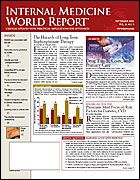Publication
Article
Internal Medicine World Report
BP Control in Chronic Kidney Disease-part Art, Part Science
Author(s):
From the American Society of Hypertension The Role of Diuretics, Aldosterone Inhibition
NEW YORK CITY?The treatment of hypertension in patients with chronic kidney disease (CKD) is challenging, because its pathophysiology is complex and has multiple components, said Domenic Sica, MD, chairman, Section of Clinical Pharmacology and Hypertension, Virginia Commonwealth University, Richmond, at the 21st Annual Scientific Meeting of the American Society of Hypertension.
"This is a devilishly difficult disease state to treat in the CKD patient. It's as much art as science as one tries to affect blood pressure control," he said. The African American Study of Kidney Disease and Hypertension (AASK) trial demonstrated that with multiple agents, getting blood pressure (BP) to goal in patients with CKD is a possible, if daunting, task. In the AASK trial, agents such as furosemide (Lasix), doxazosin (Cardura), clonidine (Catapres), hydralazine (Apresoline), and minoxidil were used successfully as add-ons to a calcium antagonist, an angiotensin-converting-enzyme (ACE) inhibitor, or a beta-blocker to achieve BP control.
The pathophysiology of hypertension in CKD involves several interrelated factors, including an inappropriately high sympathetic outflow, variable patterns of cardiac output, vasoconstriction, abnormal salt and water handling, a variety of abnormalities in the renin-angiotensin system (RAS), and, separately, the aldosterone axis and variable patterns of vasoconstriction and venous return.
"This is not a static illness; it's a fluid illness as to the factors that are operational in the genesis and probably the perpetuation of hypertension in these patients," said Dr Sica.
Treating hypertension in patients with CKD should not have as its goal the singular issue of attempting to reach a target BP but rather an integrative measure of BP reduction over the full 24 hours, he said.
The normal diurnal pattern of BP begins to change early in CKD. One tangible product of unchecked sympathetic activation is a nocturnal BP that increases instead of dips.
Unfortunately, no currently marketed antihypertensive agents effectively lower sympathetic activity. Therefore, BP control in CKD patients requires controlling for volume, pulse rate, and activation of the sympathetic nervous system and the RAS, he said. Alternative treatment recommendations are listed in the Table.
Another consideration in selecting therapy is recognizing that the kidney is not just an organ that is acted upon by chosen medications, but it is also an organ that is linked to clearance of these medications. Drug elimination for renally cleared compounds starts to decrease at a glomerular filtration rate (GFR) of about 60 mL/min/1.73 m2, with an incremental inability to excrete drugs as GFR drops further. For this reason, subtherapeutic or submaximal doses of renally cleared antihypertensive agents may suffice for patients with CKD.
Thiazide diuretics are important for volume control in CKD patients with hypertension. A transition from thiazide diuretics to loop diuretics is advisable as patients exhibit some loss of response to diuretics, usually when GFR drops to ≤60 mL/min/1.73 m2.
However, high doses of loop diuretics can have a prominent hypercalciuric effect that can be muted or attenuated significantly by coadministration of a thiazide diuretic. "It is not irrational to use metolazone [Zaroxolyn] or chlorthalidone [Hygroton] as adjunct therapy to loop diuretics, and not necessarily only in the profoundly diuretic-resistant patient, but as a way to spare individuals high loop diuretic doses," he said.
Not all forms of CKD are characterized by an abundance of volume excess. In some cases, casual diuretic therapy may be sufficient, said Dr Sica. A heavy degree of proteinuria, however, signals a change in volume state that requires a change in diuretic regimen.
Normally, a dose-response relationship exists with diuretic therapy, unless the patient has heart failure or a significant degree of proteinuria. These patients do not necessarily have an abnormal response to diuretics but "simply an inability to put drug into the urine compartment, which is the effect compartment for the diuretic to elicit the diuretic response you need," said Dr Sica. "The tempering influence on the diuretic is the GFR, because that defines your filtered load. Without a filtered load?you can only have so much urine output."
When selecting diuretics, well-absorbed diuretics are preferred, he said. "Furosemide is tainted to a degree by a very poor absorption profile and an unpredictable absorption profile," he said.
Introduction of a drug that inhibits the RAS or aldosterone may promote additional BP reduction when volume is controlled. "If you take volume off an individual, you can activate the renin axis?and you can activate aldosterone. In so doing, you may be able to come in with a drug blocking either of these axes and get an augmented effect," he said. "Often, you want to stage a sequential volume reduction and create a platform upon which you can introduce a RAS blocker or an aldosterone receptor antagonist," he added.
"I can almost always accomplish more in BP reduction by blocking aldosterone than by blocking the angiotensin type 1 receptor or the angiotensin-converting enzyme," Dr Sica explained. Aldosterone receptor antagonists and beta-blockers decrease plasma aldosterone levels; ACE inhibitors and angiotensin receptor blockers (ARBs) are associated with an initial decrease in plasma aldosterone, followed by a long-term increase.
The relationship between dose and therapeutic response for agents that decrease RAS activity is affected by volume status. In a volume-expanded state, ACE inhibitors and ARBs do not reduce BP effectively. "They require volume reduction to extract their major effect," Dr Sica said.
In the end, multiple rational combinations of agents can be tried to achieve BP reduction in the patient with CKD and hypertension, as evidenced by the AASK trial.
Key points
When treating patients with CKD, the goal should not be simply to reach a target BP but rather an integrative measure of BP reduction over the full 24 hours.
No existing antihypertensive agents can effectively reduce sympathetic activity.
When selecting diuretics, choose the agents that are well-absorbed.
Remember that multiple rational drug combinations can be used to achieve BP reduction in patients with CKD and hypertension.






